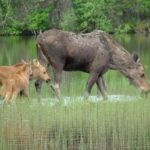Maine Street, Rangeley.
By Victor Block
Digging our paddles into the shallow water, my son Tom and I steered our canoe around a sharp turn in the river. Suddenly, we were face-to-face – or, more accurately, face-to-knees – with a massive creature standing directly in our path. Another day, another moose!
Lifting its head to stare at us, tender shoots of river greens cascading from its mouth, the animal seemed undisturbed. After several minutes, our temporary companion finished its meal, took a final, I thought disdainful, glance in our direction and slowly ambled into the woods.
Welcome to the Rangeley Lakes region of Maine, nestled in the state’s less-visited western lakes and mountains region. For me, the picture-book village of Rangeley is the “real” Maine, a town of 1,100 residents that captures the quaint nostalgia of a Norman Rockwell painting.
Single-story frame buildings along Main Street house the Lakeside Theater, aptly named Moose Alley Bowling, and a smattering of shops and restaurants. No stop light interrupts the sparse flow of vehicles, many of them with a kayak or canoe strapped to the top.
It doesn’t take long to understand that this area of Maine is as much a lifestyle as a destination. Most folks pick up their mail at the tiny post office, where locals gather to exchange news and gossip in an outpouring of “heahs,” “a-yups” and other Maine-speak.
Visitors long have been lured by the unspoiled beauty of western Maine. Abnaki Indians set up hunting and fishing camps along shorelines of the area’s lakes and ponds. Names of some bodies of water – Cupsuptic, Umbagog and tongue-twisting Mooselookmeguntic – attest to the Indian influence.
In 1796, an Englishman named James Rangeley showed up and purchased over 30,000 acres in the area. When a town was incorporated on the site in 1855, it had 258 inhabitants.
It was about then that Rangeley began to gain a reputation as a fishing mecca for its abundance of brook trout and landlocked salmon. Well-to-do fishermen from Boston, New York and further away made the trek to the still primitive destination, and grand hotels sprung up to accommodate them.
Two railroad lines brought sportsmen to the region and steamboats transferred them to a half-dozen sprawling lodges along the shoreline of Rangeley Lake.
The Depression brought an end to the gilded age in Rangeley, but not to its appeal as a year-round getaway destination with something-for-everyone variety. Golfers choose between the Mingo Springs course in town, with dramatic lake and mountains views from every hole, and nearby Sugarloaf, which Golf Magazine has ranked among the 20 best public courses in the country.
Tennis courts are adjacent to the tiny Chamber of Commerce building, near the town beach. Canoes and kayaks dot lakes and rivers, joined by sail and powerboats, and wind surfers. Mountain bikers find challenge on hilly roadways and off-road forest trails.
Fall attracts deer, bear, small game and bird hunters, and provides Mother Nature with an opportunity to put on her spectacular annual Technicolor display of fiery foliage.
In winter, snowmobilers find more than 140 miles of well-groomed trails that interconnect with systems leading throughout Maine and into Canada. There’s skiing 30 miles away at Sugarloaf Mountain, Maine’s second tallest peak, which is the largest ski area east of the Rockies in terms of developed skiable terrain.
When it comes to museums, Rangeley is no New York. But it makes up in atmosphere and charm what it may lack in number and size.
The Rangeley Lakes Historical Society provides an introduction to the region with a variety of intriguing exhibits. They include guest registers, silverware and old photographs from the fine old hotels that once lined Rangeley Lake, and artifacts from paddlewheel boats that transported guests to their accommodations. Also on display are over 100 creations by Carrie Stevens, a milliner who used her hat-making skills to fashion what became world-famous fishing flies.
The Rangeley Lakes Region Logging Museum contains tree-cutting machinery – donkey engines, snubbing machines and skidders – that comprise an entire new vocabulary. Also on display are original oil paintings that depict the logging process of the 1920s, and taped oral histories presented by loggers and their families.
The area’s colorful history also is kept alive at the Outdoor Sporting Heritage Museum. Displays range from 10,000-year-old Paleo Native American artifacts and antique sporting equipment to original world-famous Rangeley Boats and numerous works of art.
Along with the eclectic list of things to see and do in Rangeley, it’s the atmosphere of a way of life from the past that attracts many people on repeat visits.
For information about Rangeley, call the Chamber of Commerce at 800-685-2537 or visit rangeleymaine.com.













